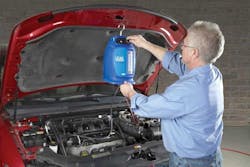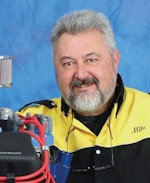A smoke machine can be used in virtually any low-pressure vehicle system for the purpose of locating leaks, including EVAP, intake/induction system, oil, EGR, engine vacuum, exhaust, coolant (radiator, water pump, hoses, etc.), HVAC, a variety of gasketed areas, engine blocks, worn throttle shafts, diaphragms, intercooler, turbocharger, idle motors and solenoids, under-dash leaks and even vehicle body wind/water leaks.
Basic leak testing
1. Locate the system port (system to be tested).
2. Install the appropriate port adapter from the smoke machine’s kit.
3. Attach the adapter to the vapor supply hose.
4. Activate the smoke machine (turn on).
5. Close any system vents.
6. Continue to fill the system until the flow meter (or indicator) shows that the system is full.
7. Visually inspect for smoke leakage (if needed, use the kit’s LED lamp to check for leaking vapor; or the kit’s UV lamp to check for dye if used).
EVAP test: Most smoke machines are designed to be used either with the shop’s compressed air supply or with an inert gas (C02 or nitrogen). Many automakers recommend the use of an inert (non-combustible) gas for inspecting EVAP systems, from a safety standpoint, since a spark or heat source could potentially ignite fuel vapors when mixed with air. Small CO2 cartridges are available (with preset regulator) for easy connection to the smoke machine’s supply. Smoke machine units also are available with a built-in air compressor, eliminating the need for an external supply connection.
[PAGEBREAK]
1. Perform tests with the engine off.
2. The vent valve is normally open with the engine off in OBD II EVAP systems. Use a scan tool to close the EVAP system for leak tests.
3. Connect the smoke machine’s power cables (red clip to battery positive and black clip to a good ground, as far away from the battery as possible).
4. Connect the charge source (if using shop air, adjust pressure according to the machine’s instructions).
5. Verify that the vehicle’s fuel level is below the base of the fuel tank neck.
6. Locate the EVAP service port (green cap). Remove the Schrader valve from the EVAP service port (this features a left-hand thread, so turn clockwise to remove).
7. Connect the machine’s service port adapter to the EVAP service port and connect the smoke machine hose.
8. Since a common cause of EVAP DTCs is a faulty or improperly installed fuel cap, don’t disturb the cap at this point. If the first test fails, then make sure that the cap is installed properly and re-test. This will rule out the cap if the problem lies elsewhere. Activate the leak test and observe the flow gauge. Allow a few minutes for the gauge to settle.
EVAP test tips:
• NOTE: In order to pressurize the system faster, press the smoke button and allow the smoke to fill the system until you hear the solenoid cycling, then press LEAK to perform the test.
• Perform testing indoors where the ambient air is stable (avoid wind or fans), to avoid the smoke from being blown around, which can make locating a leak difficult.
• Remove the fuel cap. This allows the system to be filled with smoke. Fill the system with smoke. After a solid stream of smoke exits the fuel tank neck, reinstall the fuel cap. Now the solenoid will cycle on and off as pressure increases.
• In order to check for intermittent leaks, wiggle EVAP system components (hoses and connections) while watching the flow meter. If an intermittent leak is found while wiggling, the flow meter rises.
Body wind/water leaks: Set the vehicle’s climate control to “fresh air” (not “recirculate”) and adjust the blower to full speed. This creates positive cabin pressure.
Connect the smoke machine’s hose to a diffuser. From outside of the vehicle, direct the smoke vapor along seal areas (door gaps, windshield trim/gaskets, window seals, etc.), with the hose placed about two to three inches away from the inspection path. If you note a disturbance in the smoke (smoke blowing back at you), this indicates the location of a cabin leak.
Smoke machines that feature a flow meter aids in determining if a leak exists (and the extent of the leak). If the flow meter indicates flow after the system is filled, this indicates the presence of a leak (the higher the ball is in the flow meter, the larger the leak). If no flow is shown on the meter, this indicates that no leak is present.
Vacuum leaks: After choosing the appropriate-size cap plug from the smoke machine kit, first fill the system with smoke before you seal the system with the cap plug. If you’re checking for intake vacuum, try to seal the intake as close to the air inlet as possible (especially important if the engine is equipped with mass airflow sensors and other ducting). Consider sealing the engine’s air filter by removing the filter, wrapping it in plastic and reinstalling the filter into its housing; or stretch a latex glove around the air passage and secure it with a large rubber band. Also, plug the exhaust tip (using the kit’s exhaust cone and plug the cone’s hose). An additional tip: Manually rotate the crankshaft so that intake and exhaust valves on the same cylinder are not open.
Select an accessible engine vacuum line and insert the smoke machine’s tapered nozzle (using the brake power booster supply hose is often a good choice to introduce smoke into the intake manifold, but if you choose the booster hose, make sure that you don’t place the booster’s check valve in between the smoke and the manifold).
Charge the system with smoke for about one minute and inspect for smoke leaks (or use a UV light to check for smoke dye).
[PAGEBREAK]
EGR leaks: Leaks at the EGR valve may be detected during a vacuum leak test. If you observe smoke exiting from the valve’s seat, gasket or diaphragm, disconnect the EGR’s vacuum hose/line and push smoke directly into the EGR valve. This will help to determine if the valve seat or diaphragm is leaking. If you suspect that the EGR ports are clogged (common problem), you can remove the EGR valve (exposing the ports) and introduce smoke through the exhaust pipe (no or little smoke indicates plugged ports).
In order to test the EGR pintle shaft, the engine must be off, and don’t cap off any part of the engine. Introduce smoke through a direct manifold vacuum source (the power booster hose for example). Turn on the smoke machine tester and observe the EGR. If a noticeable amount of smoke exits the valve, cap off the intake and plug the exhaust pipe tip. Introduce smoke. A small amount of smoke indicates an acceptable EGR valve.
Brake booster leaks: Disconnect the booster’s vacuum supply hose and introduce smoke directly into the booster (eliminate the check valve for this test). Check for smoke exiting the booster canister (crimped areas, etc.), and check underdash for smoke exiting through the rear of the booster (don’t depress the brake pedal during this test).
Engine oil seal/gasket leaks: Remove the engine’s oil dipstick. Connect a snug-fitting section of hose over the dipstick tube and insert the smoke machine’s hose nozzle into the hose. Plug the PCV, air breather and air intake. Temporarily remove the oil fill cap. Pump smoke into the crankcase until you see smoke exiting from the oil fill port, and reinstall the oil fill cap. Continue introducing smoke through the dipstick tube. Inspect the engine for leaks, looking for smoke, dripping or bubbling oil. To find a coolant leak using a smoke machine it’s best to first drain the coolant from the system, then pump smoke into the radiator.
Turbocharger/intercooler leaks: With the engine off, connect the smoke machine to the engine’s intake system, introducing smoke into the “cold” side of the turbocharger. Once charged with smoke, inspect the cold side of the turbo, the intercooler, ductwork, and the wastegate for leaks. Next, pump smoke into the exhaust pipe tip (using the cone adapter) and check for smoke exiting the “hot” side of the system (exhaust piping, exhaust manifold and the hot side of the turbo).
Exhaust leaks: With the vehicle raised on a lift and with the engine off, wait until the exhaust system is cold (due to thermal expansion, leaks will be easier to find on a cold system). Seal off the air intake, and adjust crankshaft position to avoid having intake and exhaust valves open on the same cylinder. Introduce smoke into the tailpipe tip (using the kit’s cone adapter). If you’re dealing with a dual exhaust, use a cone (and T-hose) for each pipe tip. Inspect for smoke exiting at any leak/poor exhaust sealing areas.
Underdash vacuum leaks: Connect the smoke machine’s supply nozzle to a main vacuum circuit that feeds through the firewall. Activate the leak test to introduce air into the system while observing the machine’s flow gauge. If the flow gauge shows zero, the system has no leaks (at this point). Continue to introduce air into the system while testing each climate control setting while observing the flow meter. If the gauge rises, a leak exists. If you suspect a leak, introduce smoke into the system (at the position on the climate control where you suspect the leak to occur). Use a light to help determine the location of the leak.
Pre-testing replacement components: It shouldn’t happen, but it does... sometimes we run into a replacement component that’s faulty, only to make the discovery after installation. A smoke machine can be used to test certain components prior to installation. In order to test components such as radiators, oil coolers or water pumps, simply plug one end and (using the correct adapter) pump smoke into the opposite end.
Smoke machine applications
Funny, but in a strange way, probably the most overlooked application is that of a general leak test. Using hand vacuum/pressure pumps, it is possible to check component level integrity, but it is difficult or even sometimes impossible to generate enough volume to provide reliable test results on larger pieces or complete systems where a large volume of air is to be displaced.
Testing the entire system is made possible with the use of a smoke machine because of the measurable volume of smoke and/or test gas (air, nitrogen, or other inert gas) flowing from the machine. Quite often, leaks are exposed that were not even suspected because they were not associated with any particular driveability symptom or customer complaint at that time. Get in the habit of using your smoke machine for problem diagnosis and general testing.
[PAGEBREAK]
• Example — Crankcase
Here is an example where a slight oil leak can be seen on an OHC four cylinder engine. At first glance, it appears that the valve cover gasket is leaking. Introducing smoke through the dipstick tube into the crankcase revealed something that wasn’t expected. Smoke was escaping from the timing belt cover which indicated that something else was leaking; likely the crankshaft and/or camshaft seal. It turns out that this vehicle was nearing the mileage interval for the timing belt to be replaced, so the leaky seals were easily confirmed and repaired when the timing belt job was performed. The seals, valve cover gasket, and timing belt replacement was the proper repair to be performed, and was easily caught with a quick smoke test of the crankcase.
It is easy to see how finding this unexpected leak led to the discussion of a much larger job. One thing led to another and it turned out the timing belt was also due for replacement. Many shops today have in place inspection programs using quick, systematic procedures (such as this example with a smoke machine) to provide better service to their customers. And at the same time, keeping their schedule (and bays) full with productive repair business.
• Example — Induction system
Introducing smoke through the air intake is a quick way to find un-metered air leaks throughout the induction system. One way is to use the tapered cone adapter that comes with your machine to connect into the system by simply opening the intake air system and inserting the cone. Notice the escaping smoke in the picture above? Look close and you may see that someone is using a zip tie (the black tab is sticking straight up) rather than the proper clamp to secure that end of the hose.
• Example — Exhaust system
Exhaust systems need to be inspected, as well. Test with the system cool so heat expansion is not a factor in the case of a small leak, and the catalytic converter will not impact the quality or quantity of your smoke.
As you can see by the flex tube leak, there are smoke machines that have UV dye solution contained in the smoke. This allows the dye to be carried airborne and deposited at the exact point of leakage. It is revealed by using a UV light and is very handy when you can see the smoke, but the leak is hidden until further disassembly allows it to be revealed. Just hit it with the UV light and look for the dye!
These are but a few examples of general purpose leak detection; there are many other applications that will likely cross your path. Let your imagination be your guide and use this technology whenever you need to verify a system or component is sealed.
Use the flow meter!
If your machine has a flow meter, before you go looking for leaking smoke, have a look at the flow meter. This is a great diagnostic aid because it instantly reacts to flow from the smoke machine. As a sealed system or component under test fills, it would be normal to see a reduction of flow from your machine. This reduction may be gradual or it may be rapid, depending on the total volume of the system under test or component under test. When this becomes important is not limited to system sealing -- it is also important when checking for restrictions.
With flow freely exiting the smoke hose you will notice the ball at the top of the flow meter. Now move the hose to the system or component to be tested. Watch the flow meter ball as you attach the hose. If it immediately drops to the very bottom, you are either testing a very small volume device which happens to be sealed at the time, or you have just discovered a total restriction near the point at which the smoke (or test gas flow if in “Test” mode on your machine) is being introduced to the system or component being tested. Collapsed hoses, plugged passages (yes this includes plugged filters!), stuck or inoperable shuttle valves – will any of these conditions affect system performance? Very likely, so this is a very important first step.
[PAGEBREAK]
• Example: Flow meter
You should always exercise the Vent Solenoid off and back on many times while observing the flow meter. Vent Valves (and Purge Valves, too) are known for intermittent sealing ability. Don’t be surprised if you see that the valve does not always seal, or if you note sticking operation where the valve stays open or closed regardless of your solenoid command.
Normally, where you find the vehicle supports bi-directional control, you will be able to control the Purge Solenoid similar to what is being discussed here on the Vent Solenoid.
Pressure decay testing is a good check for post repair integrity verification. It is NOT used to measure leak size (that is a flow meter function). It is also important to realize that how quickly the pressure gauge responds can be impacted dramatically by the potential volume of a system or component being tested. For example, when filling an EVAP system with smoke (Vent Valve OPEN) the pressure on the gauge of your smoke machine and the FTP sensor reading will be quite a bit different. Once the vent valve is closed the system pressure being reported by the FTP and that on the pressure gauge will come more in line as system pressure stabilizes, but only to the span of the FTP sensor’s range. Also, be aware that in many cases, FTP sensors have more range on the negative pressure side of zero than on the positive pressure side of zero.
* Example – IWC pressure gauge
Use your smoke machine to apply pressure to the EVAP System (no need to exceed 13 IWC), and the bi-directional control on your scan tool to energize the vent solenoid and close the vent valve (where the Vent Valve is normally OPEN). Run your smoke machine to achieve a desired test pressure on the system and then turn off your smoke machine. Once pressures have stabilized, compare the scan tool FTP PID to pressure displayed on your smoke machine’s pressure gauge. This process tests the POSITIVE Pressure side of the FTP Sensor.
To test the NEGATIVE Pressure side of the FTP Sensor, leave your smoke machine turned off, but the smoke hose connected to the EVAP System. Navigate your bi-directional scan tool to the menu in which you are able to activate the Purge Valve. Exercise the Purge Valve to bring system pressure to a desired negative test pressure (no need to exceed 13 IWC) and again compare the FTP PID to the negative pressure displayed on your smoke machine’s pressure gauge.
This is a fast, easy way to not only verify the accuracy of static system values being reported by the FTP Sensor, but to also see the full range of sensor response and accuracy on both sides of zero.
[PAGEBREAK]
With the solenoid on, the vent valve is closed, and smoke flow into the EVAP system has now reduced to a point well below the minimum threshold required to turn on the MIL.
Smoke machine sources
Bosch — SMT 300 www.boschdiagnostics.com
Motorvac — Cool Smoke www.motorvac.com
OTC — LeakTamer www.otctools.com
Redline — Smoke Pro www.redlinedetection.com
Smoke Wizard www.smokewizard.com
Star Envirotech www.starenvirotech.com/smoke.html
Vacutec — Leakfinder Series www.vacutec.com



